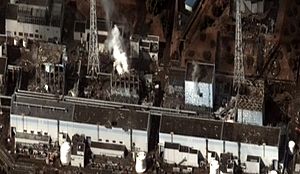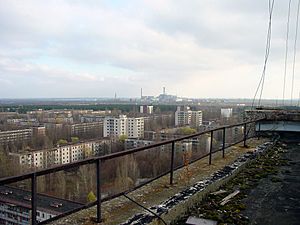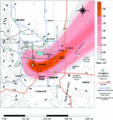Nuclear and radiation accidents facts for kids


Nuclear disasters are serious events that happen at places like nuclear power plants or other facilities that use radioactive materials. These accidents can release harmful radiation into the environment. This page lists some of the most serious nuclear accidents that have happened around the world.
One of the worst nuclear accidents was the Chernobyl disaster in 1986. It happened in Ukraine. This accident directly caused 30 deaths. It also caused about $7 billion in property damage. A study from 2005 estimated that up to 4,000 more cancer deaths might be linked to the accident. These deaths would be among people exposed to high radiation levels. Radioactive fallout spread across parts of Belarus, Ukraine, and Russia. About 350,000 people had to move away from these areas soon after the accident.
Some very serious nuclear accidents have also happened with nuclear submarines. These accidents often involved many deaths. So far, all these submarine accidents happened with units from the former Soviet Union.
Contents
Understanding Nuclear Accidents
Why Accidents Happen: Normal Accidents Theory
A book called "Normal Accidents" was written in 1984 by Charles Perrow. He was a sociologist from Yale. His book looked closely at how complex systems work. He was the first to describe how risky complex systems like nuclear power plants can be. Perrow explained that many unexpected problems are built into complex systems. These systems are also tightly connected. This means one small problem can quickly lead to bigger ones. Such accidents are hard to prevent, even with good design.
Perrow got the idea for his book from the 1979 Three Mile Island accident. In this event, a nuclear accident happened because many small failures happened at once. These failures interacted in unexpected ways. This accident was a "normal accident" because it was surprising and hard to control. It also seemed unavoidable.
Perrow's ideas are based on three main points. First, people make mistakes, even in nuclear plants. Second, big accidents almost always start from very small issues. Third, many failures are due to how organizations work, not just the technology. These ideas are still important today.
Major Nuclear Power Plant Accidents
| Date | Location of accident | Description of accident | Dead | Cost ($US millions 2006 ) |
INES Scale |
|---|---|---|---|---|---|
| October 10, 1957 | Sellafield, Cumberland, United Kingdom | A fire at a British atomic bomb project destroyed the core. It released radioactive material into the environment. | 0 | 5 | |
| January 3, 1961 | Idaho Falls, Idaho, United States | An explosion at the SL-1 prototype killed all 3 operators. This happened when a control rod was pulled out too far. | 3 | 22 | 4 |
| October 5, 1966 | Frenchtown Charter Township, Michigan, United States | A partial core meltdown happened at the Fermi 1 Reactor. | 0 | 132 | |
| January 21, 1969 | Lucens reactor, Vaud, Switzerland | Coolant was lost, causing a partial core meltdown. This led to a lot of radioactive contamination. The area was then sealed off. | 0 | 4 | |
| 1975 | Sosnovyi Bor, Leningrad Oblast, Russia | There were reports of a partial nuclear meltdown at the Leningrad nuclear power plant unit 1. | |||
| December 7, 1975 | Greifswald, East Germany | An electrical error caused a fire. It destroyed control lines and five main coolant pumps. | 0 | 443 | 3 |
| January 5, 1976 | Jaslovské Bohunice, Czechoslovakia | A problem happened during fuel replacement. A fuel rod was ejected into the reactor hall by the coolant. | 2 | 4 | |
| February 22, 1977 | Jaslovské Bohunice, Czechoslovakia | Severe corrosion of the reactor happened. Radioactivity was released into the plant area. This required the plant to be completely shut down. | 0 | 1,700 | 4 |
| March 28, 1979 | Three Mile Island, Pennsylvania, United States | Coolant was lost, and a partial core meltdown happened due to operator mistakes. A small amount of radioactive gases was released. | 0 | 2,400 | 5 |
| September 15, 1984 | Athens, Alabama, United States | Safety rule violations, operator errors, and design problems caused a six-year shutdown at Browns Ferry Unit 2. | 0 | 110 | |
| March 9, 1985 | Athens, Alabama, United States | Instrumentation systems failed during startup. This led to stopping operations at all three Browns Ferry Units. | 0 | 1,830 | |
| April 11, 1986 | Plymouth, Massachusetts, United States | Repeated equipment problems forced an emergency shutdown of Boston Edison’s Pilgrim Nuclear Power Plant. | 0 | 1,001 | |
| April 26, 1986 | Chernobyl disaster, Ukrainian SSR | Overheating, a steam explosion, fire, and meltdown occurred. This led to the evacuation of 300,000 people. Radioactive material spread across Europe. | 56 direct; 4,000 to 985,000 cancer |
6,700 | 7 |
| May 4, 1986 | Hamm-Uentrop, Germany | The experimental THTR-300 reactor released small amounts of radioactive materials into the surrounding area. | 0 | 267 | |
| March 31, 1987 | Delta, Pennsylvania, United States | Peach Bottom units 2 and 3 were shut down due to cooling problems and unexplained equipment issues. | 0 | 400 | |
| December 19, 1987 | Lycoming, New York, United States | Malfunctions forced Niagara Mohawk Power Corporation to shut down Nine Mile Point Unit 1. | 0 | 150 | |
| March 17, 1989 | Lusby, Maryland, United States | Inspections at Calvert Cliff Units 1 and 2 found cracks. This forced long shutdowns. | 0 | 120 | |
| March 1992 | Sosnovyi Bor, Leningrad Oblast, Russia | An accident at the Sosnovy Bor nuclear plant leaked radioactive gases and iodine into the air. This happened through a broken fuel channel. | |||
| February 20, 1996 | Waterford, Connecticut, United States | A leaking valve forced the shutdown of Millstone Nuclear Power Plant Units 1 and 2. Many equipment failures were found. | 0 | 254 | |
| September 2, 1996 | Crystal River, Florida, United States | Equipment problems forced a shutdown and major repairs at Crystal River Unit 3. | 0 | 384 | |
| September 30, 1999 | Ibaraki Prefecture, Japan | The Tokaimura nuclear accident killed two workers. Another worker was exposed to very high radiation levels. | 2 | 54 | 4 |
| February 16, 2002 | Oak Harbor, Ohio, United States | Severe corrosion of a control rod caused a 24-month shutdown of the Davis-Besse reactor. | 0 | 143 | 3 |
| August 9, 2004 | Fukui Prefecture, Japan | A steam explosion at Mihama Nuclear Power Plant killed 4 workers and injured 7 others. | 4 | 9 | 1 |
| July 25, 2006 | Forsmark, Sweden | An electrical problem at Forsmark Nuclear Power Plant caused one reactor to shut down. | 0 | 100 | 2 |
| March 11, 2011 | Fukushima, Japan | A tsunami flooded and damaged 5 active reactor plants. Two workers drowned. Loss of backup power led to overheating, meltdowns, and evacuations. One man died during cleanup. | 7 | ||
| 12 September 2011 | Marcoule, France | One person was killed and four injured in an explosion. This happened in a furnace used to melt metallic waste at the Marcoule Nuclear Site. | 1 |
Nuclear Submarine Accidents
Some of the most serious nuclear accidents have happened on nuclear submarines. All of these have involved submarines from the former Soviet Union. These accidents often caused damage to the reactor core. They also released radioactivity. Here are some examples:
- K-8, 1960: This submarine had a loss-of-coolant accident. A lot of radioactivity was released.
- K-14, 1961: The reactor part was replaced due to problems with its safety systems.
- K-19, 1961: A loss-of-coolant accident led to 8 deaths. More than 30 other people were exposed to too much radiation. The movie K-19: The Widowmaker tells this story.
- K-11, 1965: Both reactors were damaged during refueling. The reactor parts were sunk in the Kara Sea in 1966.
- K-27, 1968: One of its reactors was damaged. This caused 9 deaths and 83 injuries. It was sunk in the Kara Sea in 1982.
- K-140, 1968: The reactor was damaged after its power increased on its own during shipyard work.
- K-429, 1970: An uncontrolled start-up of the reactor led to a fire and radioactivity release.
- K-116, 1970: A loss-of-coolant accident happened in the port reactor. A lot of radioactivity was released.
- K-64, 1972: The first Alfa-class reactor failed. The reactor part was scrapped.
- K-222, 1980: This submarine had a reactor accident during maintenance. This happened while the crew was away.
- K-123, 1982: The Alfa-class submarine's reactor core was damaged by a coolant leak. The submarine was out of service for eight years.
- K-431, 1985: A reactor accident during refueling caused 10 deaths. 49 other people suffered radiation injuries.
- K-219, 1986: An explosion and fire happened in a missile tube. This led to a reactor accident. A 20-year-old sailor, Sergei Preminin, gave his life to secure one of the reactors. The submarine sank three days later.
- K-192, 1989: This submarine had a loss-of-coolant accident. It was reclassified from K-131.
Radiotherapy Accidents
Radiotherapy uses radiation to treat diseases like cancer. But sometimes, accidents can happen with these machines or radioactive sources. These accidents can cause serious harm or even death if people get too much radiation.
| Year | Type | Accident | ARS fatalities | ARS survivors | Location |
|---|---|---|---|---|---|
| 1957 | alleged crime | Nikolay Khokhlov assassination attempt | 0 | 1 | Frankfurt, West Germany |
| 1962 | orphan source | radiation accident in Mexico City | 4 | ? | Mexico City, Mexico |
| 1985 | radiotherapy | Therac-25 radiation overdose accidents | 3 | 3 | |
| 1984 | orphan source | radiation accident in Morocco | 8 | 3 | Mohammedia, Morocco |
| 1987 | orphan source | Goiânia accident | 4 | ? | Goiânia, Brazil |
| 1990 | radiotherapy | radiotherapy accident in Zaragoza | 11 | ? | Zaragoza, Spain |
| 1996 | radiotherapy | radiotherapy accident in Costa Rica | 7 to 20 | 46 | San José, Costa Rica |
| 2000 | orphan source | Samut Prakan radiation accident | 3 | 7 | Samut Prakan Province, Thailand |
| 2000 | radiotherapy | Instituto Oncologico Nacional accident | 3 to 7 | ? | Panama City, Panama |
| 2006 | crime | Poisoning of Alexander Litvinenko | 1 | 0 | London, United Kingdom |
| 2010 | orphan source | Mayapuri radiological accident | 1 | 7 | Mayapuri, India |
Images for kids
-
Dr. Joseph G. Hamilton was the primary researcher for the human plutonium experiments done at U.C. San Francisco from 1944 to 1947. Hamilton wrote a memo in 1950 discouraging further human experiments because the AEC would be left open "to considerable criticism," since the experiments as proposed had "a little of the Buchenwald touch."
-
One of four example estimates of the plutonium (Pu-239) plume from the 1957 fire at the Rocky Flats Nuclear Weapons Plant near Denver, Colorado. Public protests and a combined Federal Bureau of Investigation and United States Environmental Protection Agency raid in 1989 stopped production at the plant.
-
Corroded and leaking 55-gallon drum, for storing radioactive waste at the Rocky Flats Plant, tipped on its side so the bottom is showing.
-
The Hanford site represents two-thirds of USA's high-level radioactive waste by volume. Nuclear reactors line the riverbank at the Hanford Site along the Columbia River in January 1960.
-
The 18,000 km2 expanse of the Semipalatinsk Test Site (indicated in red), which covers an area the size of Wales. The Soviet Union conducted 456 nuclear tests at Semipalatinsk from 1949 until 1989 with little regard for their effect on the local people or environment. The full impact of radiation exposure was hidden for many years by Soviet authorities and has only come to light since the test site closed in 1991.
-
Over 2,000 nuclear tests have been conducted, in over a dozen different sites around the world. Red Russia/Soviet Union, blue France, light blue United States, violet Britain, black Israel, yellow China, orange India, brown Pakistan, green North Korea and light green Australia (territories exposed to nuclear bombs)
-
Radioactive materials were accidentally released from the 1970 Baneberry Nuclear Test at the Nevada Test Site.
-
The recovered thermonuclear bomb was displayed by U.S. Navy officials on the fantail of the submarine rescue ship U.S.S. Petrel after it was located in the sea off the coast of Spain at a depth of 762 meters and recovered in April 1966
-
A sketch used by doctors to determine the amount of radiation to which each person had been exposed during the Slotin excursion
See also
 In Spanish: Accidente nuclear para niños
In Spanish: Accidente nuclear para niños














